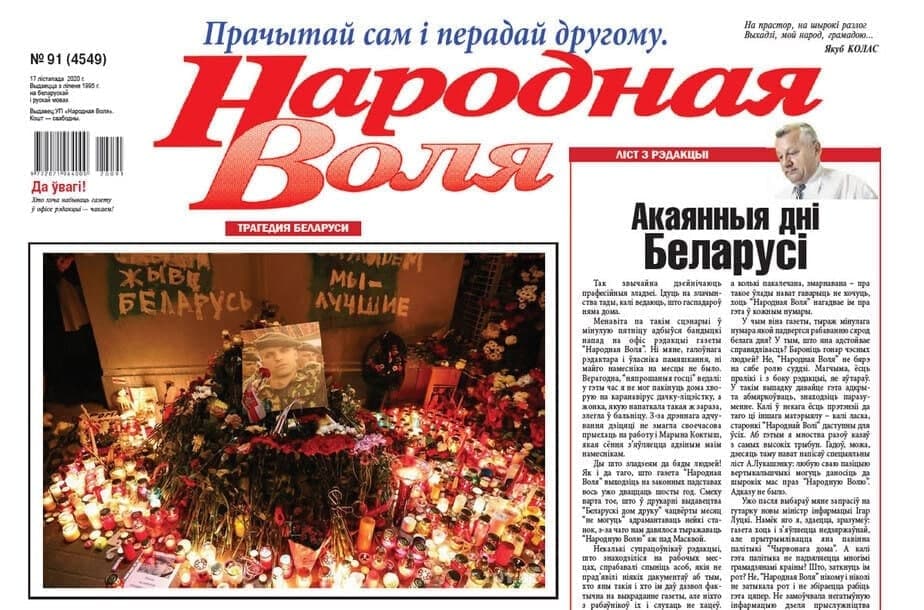Five years of lawlessness: How Belarus’s media was silenced — and fought back
Independent media can be destroyed, journalists can be imprisoned — but they cannot be forced into silence. The starting point of the newest Belarusian history was August 9, 2020 — the day of voting in a presidential election that never truly happened. That day marked the beginning of a total purge of Belarus’s democratic society.
Over the past five years, the regime has “normalized” Belarusians: opponents of Aliaksandr Lukashenka are in prison, the third sector has been destroyed, and independent lawyers have been eliminated as a profession.
The Belarusian media landscape has also completely changed. Independent outlets have been driven out of the country, replaced by Russian and Belarusian state propaganda.
In terms of press freedom, Belarus ranks 159th out of 161 countries, according to the human rights group Article 19. In the 2025 World Press Freedom Index, Reporters Without Borders ranked Belarus 166th out of 180 countries.
What happened to independent media after 2020
Almost all national socio-political publications left Belarus due to repression and criminal prosecution. More than 30 outlets now operate from abroad. Despite this, the vast majority of “exiled” media have survived and continue to work.
But there have been losses. Some outlets that played a major role in national and regional journalism disappeared (at least temporarily) from the media map: Narodnaya Volya, Belaruski Partizan, Rehijanalnaja Hazeta from Maladzechna, Borisovskie Novosti, Intex-press from Baranavichy, Info-Kurier from Slutsk, Ranak from Svetlahorsk, Brestski Kurier, and several others.

Narodnaya Volya
The authorities fear independent media even in exile
That is why the Belarusian regime widely practices labeling independent media as “extremist content” and “extremist formations.” This allows security forces to prosecute people, both administratively and criminally, for reading the “wrong” outlets.
According to Information Minister Marat Markau, since 2020 the authorities have restricted 18,000 information resources, almost 7,000 of which have been declared “extremist.” Last year alone, 3,150 resources received this label.
“On the information front, state media must have all types of weapons and tools,” the minister said. And if official media lose this war, “we will have to enter a hot phase, a real war.” How easy it is to disguise the fear of losing power as war talk!
Hardly a day passes without new information resources being labeled “extremist.” For example, on July 30 the KGB declared the coalition Green Network an “extremist formation.” It includes the projects Belarus Beehive, Green Portal, and Ecohome.
Not only national media are labeled extremist — foreign outlets are targeted too, such as the Lithuanian portal DELFI or the Polish website Kresy24.pl.
Repression against journalists
The start of protests in August 2020 opened a “hunting season” on independent journalists. The Belarusian regime follows the principle: no journalist — no pictures or information — and then TV can safely broadcast “stability.”
On August 10 in Minsk, a security officer deliberately shot Nasha Niva photojournalist Natallia Lubneuskaya. She was wearing a blue PRESS vest, impossible to miss from ten meters away. Fortunately, the bullet was rubber.

Colleagues help wounded Natallia Lubneuskaya leave the protest site. Photo: Uladz Hrydzin
Colleagues help wounded Natallia Lubneuskaya leave the protest site. Photo: Uladz Hrydzin
More than 500 media workers have faced repression organized by the Belarusian regime. At this very moment, 38 journalists are behind bars on politically motivated charges. The BAJ counter tracks the number of imprisoned journalists and their sentences.
On July 25, Brest freelance journalist Danil Palianski was charged with “treason” and sentenced to 10 years in prison.
Since 2020, 31 journalists have been released from correctional facilities and remand prisons following criminal prosecution. One of the most recent was former RFE/RL Belarus journalist Ihar Karnei, freed as part of Belarus‑U.S. negotiations and immediately deported to Lithuania.
According to the Council of Europe’s Platform for the Protection of Journalism and Safety of Journalists, in 2024 Belarus led Europe in the number of jailed journalists. A total of 159 journalists were in custody, with the largest share — 44 — in Belarus, followed by 30 in Azerbaijan, 29 in Russia, 28 in Russian-occupied areas of Ukraine, 27 in Turkey, and 1 in Georgia.

Mass detention of journalists during the 2020 protests in Minsk. Photo: TUT.BY
Mass detention of journalists during the 2020 protests in Minsk. Photo: TUT.BY
Is everything lost, or we won’t give the authorities the satisfaction?
The destruction, criminal prosecution, and exile of media provoked a counter-reaction — dozens of new projects appeared in the Belarusian media space. These include new social media-based outlets as well as traditional media. Notable examples include the Belarusian Investigative Center, Buro Media, Pozirk, Plan B, Sojka, MOST, Palatno, the Belarusians Can project, Aliaksandra Khanevich’s YouTube channel, Ministerstva Sepultury, Ziolki Show, Jana/Joj, and Zahlanie Sontsa. This is far from a complete list.
TikTok channels with millions of followers have emerged. Telegram channels have significantly increased the speed of information delivery.
Investigative journalism based on open data, international sources, and CyberPartisans leaks has reached the international level — something unimaginable before 2020.
Belarusian journalists have become more integrated into the international agenda, collaborating with Polish, Lithuanian, Ukrainian, and Western media, which helps keep the Belarus issue visible worldwide. Support for Belarusian journalists echoes from Australia to Canada.
BAJ’s special project Without us you wouldn’t know… shows which facts, events, and problems in Belarus would have gone unseen without independent media.
Belarus’s independent media: A one-of-a-kind example in Europe
Inside the country, however, conditions are the worst in the history of independent Belarusian journalism. Russian propaganda is competing for the audience of blocked and exiled media, while the tone of Belarusian state propaganda has become more aggressive. Authorities openly promote projects that mimic independent outlets but push the state’s agenda. This policy most affects the younger generation, which never witnessed 2020 firsthand.
“Indeed, the working conditions for independent media have radically changed since 2020,” says BAJ deputy chair Barys Haretski. “The number of information sources has significantly decreased. Unfortunately, independent Belarusian journalists have been deprived of the right to work on the ground. But even in such extreme conditions, independent media maintain a presence through open sources, investigative journalism, and officials’ comments. Without a doubt, the example of Belarus’s independent media sector is unique in Europe.
The past five years have shown: media can be destroyed financially and legally, driven into exile, labeled ‘extremist.’ But no one has yet been born who can make the independent press be silent.”
 @bajmedia
@bajmedia
